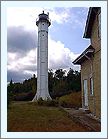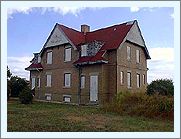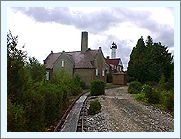|
Historical
Information

After the 1864 completion of the Peninsula Railroad connecting
Escanaba to the iron mines of Negaunee, maritime commerce in and out of
Escanaba exploded as vessels loaded with ore left the growing port
headed for the hungry steel mills along the shores of the eastern lakes.
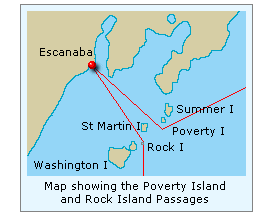 Departing
Escanaba, and heading for the open waters of Lake Michigan, vessels were
forced to thread their way through a chain of islands which spread
themselves across the entrance to Green Bay between the Door and Garden
peninsulas. Traffic setting off to coast the north shore into the
Straits took the more northerly Poverty Island Passage, while vessels
bound for the southern ports of Lake Michigan took St. Martin Passage
between St. Martin Island on the west and Little Gull Island to the
east. Departing
Escanaba, and heading for the open waters of Lake Michigan, vessels were
forced to thread their way through a chain of islands which spread
themselves across the entrance to Green Bay between the Door and Garden
peninsulas. Traffic setting off to coast the north shore into the
Straits took the more northerly Poverty Island Passage, while vessels
bound for the southern ports of Lake Michigan took St. Martin Passage
between St. Martin Island on the west and Little Gull Island to the
east.
St. Martin Island was a wooded and
hilly island approximately 2 ¼ miles in length by 1 ¼ miles in width,
tapering gradually at its southeast end until it disappeared beneath the
waves. However this disappearance was deceptive, since the island
continued just beneath the surface for an additional 1 3/8 miles, with
St. Martin Island Shoal sitting 1 mile yet beyond the end of the spit.
In order to guide mariners through the
passage, and to warn them of the shoals lurking just beneath the water,
the Lighthouse Board requested an appropriation of $15,000 for the
construction of a Fourth Order Light Station and fog signal on St.
Martin Island in its 1891 annual report. After Congress chose to ignore
the request, the Board felt strongly enough about the necessity of the
station that it reiterated its request in its reports for the following
seven years.
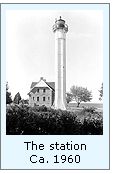 Congress
finally responded with the requested appropriation on July 1, 1898, and
a survey party was dispatched from Chicago to identify the best location
for the station in September of that same year. Selecting an area on the
island's narrow southeast point, information on ownership was obtained
from the General Land Office, and negotiations to obtain title began. As
was often the case, the owners of the land did not wish to sell, and
since work on the station could not proceed until clear title had been
obtained, the matter rested in the courts until free title was finally
obtained in 1901. The District Engineer immediately began drafting the
plans and specifications for a unique iron tower for the station, and
proposals for furnishing the required metal work were invited. Congress
finally responded with the requested appropriation on July 1, 1898, and
a survey party was dispatched from Chicago to identify the best location
for the station in September of that same year. Selecting an area on the
island's narrow southeast point, information on ownership was obtained
from the General Land Office, and negotiations to obtain title began. As
was often the case, the owners of the land did not wish to sell, and
since work on the station could not proceed until clear title had been
obtained, the matter rested in the courts until free title was finally
obtained in 1901. The District Engineer immediately began drafting the
plans and specifications for a unique iron tower for the station, and
proposals for furnishing the required metal work were invited.
The required minimum of three
competitive bids were received, however all three of them were well in
excess of the amount allocated for the tower portion of the project.
Thus, it became immediately apparent that material costs had escalated
significantly over the ten years since the original cost estimates were
drawn-up, and that the station could no longer be built within the
amount of the 1891 appropriation. After evaluation, the Board requested
an appropriation of an additional $14,000 in its 1901 annual report,
bringing the total requested funds for the station to $29,000.
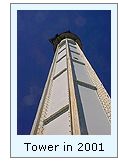 While
Congress balked at the request for $14,000, an act was passed on January
28, 1902 appropriating $10,000 for the project, for a total
appropriation of $25,000. Bids for the tower iron work and fog signal
plant were advertised, and a contractors selected for their supply.
However, as a result of significant raw material shortages, the
contractors broke the bad news that they would be unable to supply the
important iron components until some time the following year. Without
the tower, it made no sense to commence construction, and the project
was put on indefinite hold until the iron work was in hand. While
Congress balked at the request for $14,000, an act was passed on January
28, 1902 appropriating $10,000 for the project, for a total
appropriation of $25,000. Bids for the tower iron work and fog signal
plant were advertised, and a contractors selected for their supply.
However, as a result of significant raw material shortages, the
contractors broke the bad news that they would be unable to supply the
important iron components until some time the following year. Without
the tower, it made no sense to commence construction, and the project
was put on indefinite hold until the iron work was in hand.
With the delivery of the fog-signal
boilers on September 2, and the iron work for the tower on September 5,
1903, a work party and the materials were delivered on St. Martin
Island, and construction began. By the time the onset of winter caused
the abandonment of construction for the season, the two-story duplex
keepers dwelling was standing to the level of second story joists, the
boathouse was complete, the concrete footings for the fog signal had
been poured, and three log cribs had been constructed and placed to form
the outer end of a boat landing.
 At
the opening of navigation in 1904, the work party returned to the island
and resumed construction. Over the following months, the full complement
of the station's buildings took shape. As was frequently the case, the
station's structures were duplicates of successful designs used
previously at other stations in the district. The two story Cream City
brick duplex keepers dwelling was built to the same plan as previously
used at Plum Island in 1897, and the cream city brick fog signal
building housing duplicate 10-inch steam whistles used the same plan as
those previously constructed at Old Mackinac in 1890 and
Beaver Island
in 1891. A standard brick oil storage building rounded-out the station's
complement of support structures. At
the opening of navigation in 1904, the work party returned to the island
and resumed construction. Over the following months, the full complement
of the station's buildings took shape. As was frequently the case, the
station's structures were duplicates of successful designs used
previously at other stations in the district. The two story Cream City
brick duplex keepers dwelling was built to the same plan as previously
used at Plum Island in 1897, and the cream city brick fog signal
building housing duplicate 10-inch steam whistles used the same plan as
those previously constructed at Old Mackinac in 1890 and
Beaver Island
in 1891. A standard brick oil storage building rounded-out the station's
complement of support structures.
The St. Martin Island tower was built
to a unique plan, never to be duplicated anywhere else on the lakes.
Hexagonal in plan, it was exoskeleton in design, consisting of six steel
vertical corner structures into which flat iron side panels were
riveted. Likely as a result of the lessons learned in the construction
of the Sturgeon Bay Canal tower in 1903, the attachment of the tower to
the foundation was buttressed with iron lattice work to help eliminate
wind induced vibration.
 At
the top of the main tower structure, the flat side plates were replaced
by curved sections, creating a circular watch room with porthole-style
windows just below the gallery. A round cast iron lantern with diagonal
astragals was centered in the gallery, containing an occulting Fourth
Order Fresnel lens illuminated by a 24,000 candlepower incandescent oil
vapor lamp. The rotating lens assembly was outfitted with flash panels
of white and red, which when rotated at the correct speed was designed
to provide the station's characteristic 10-second repeated cycle
consisting of a red flash of 0.2 seconds, an eclipse of 4.8 seconds, a
white flash of 0.2 seconds followed by and eclipse of 4.8 seconds. From
the foundation to the top of the ventilator ball atop the roof, the
tower stood 57 feet, with its location on the island providing a focal
plane of 84 feet, and a range of visibility of 17 miles in clear
conditions. At
the top of the main tower structure, the flat side plates were replaced
by curved sections, creating a circular watch room with porthole-style
windows just below the gallery. A round cast iron lantern with diagonal
astragals was centered in the gallery, containing an occulting Fourth
Order Fresnel lens illuminated by a 24,000 candlepower incandescent oil
vapor lamp. The rotating lens assembly was outfitted with flash panels
of white and red, which when rotated at the correct speed was designed
to provide the station's characteristic 10-second repeated cycle
consisting of a red flash of 0.2 seconds, an eclipse of 4.8 seconds, a
white flash of 0.2 seconds followed by and eclipse of 4.8 seconds. From
the foundation to the top of the ventilator ball atop the roof, the
tower stood 57 feet, with its location on the island providing a focal
plane of 84 feet, and a range of visibility of 17 miles in clear
conditions.
Finally, since the boat landing was so
far from the station buildings, an iron-tracked tramway was constructed
between the two to allow for the easy transportation of supplies from
the landing to the station.
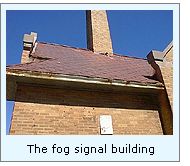 Construction
at St. Martin Island was completed on June 15, 1904. However a shortage
of government funds precluded the hiring of keepers to man the station
until the opening of the navigation season in 1905, and during that
first year of operation the station's keepers fed 13 cords of wood to
the boilers to keep the 10-inch team whistles wailing for a total of 110
hours. Construction
at St. Martin Island was completed on June 15, 1904. However a shortage
of government funds precluded the hiring of keepers to man the station
until the opening of the navigation season in 1905, and during that
first year of operation the station's keepers fed 13 cords of wood to
the boilers to keep the 10-inch team whistles wailing for a total of 110
hours.
At some time prior to 1939, the 10-inch
steam whistles were removed from the fog signal building and replaced
with a diaphone fog
signal. During this time period the station was also
electrified, and telephone service run to the station. At a yet to be
determined date, the light was automated through the installation of a
190 mm acrylic lens, and the Fourth Order Fresnel was shipped to Point
Iroquois Light Station, where it can be seen to this day displayed in
the fine museum in the keepers dwelling. After automation, the St.
Martin Island structures were boarded-up and abandoned to the elements,
save for infrequent maintenance visits by Coast Guard crews.
Today, the entire island is under
private ownership, with the area around the lighthouse controlled by a
Native American tribe. While boarded-up, the
structures on St. Martin have fared much better than those on nearby
Poverty Island, which have been completely abandoned, and have
thus succumbed to years of ceaseless vandalism.

Keepers of this
Light

Click Here to see a complete listing of
all St. Martin Island Light keepers compiled by Phyllis L. Tag of Great
Lakes Lighthouse Research.

Seeing this
Light

We have yet to visit this light station, and since the entire island is
now under private ownership, it is unlikely that we will be able to find
an opportunity to take close-up photographs of the historic light
station structures ourselves. We wish to take this
opportunity to thank Larry Bell for kindly offering to share his
photographs of the station taken during his jet ski visit to the island in September of 2001.

Finding this Light

With the Island under private ownership, visitors to the island are
discouraged in order to dissuade vandalism. We are presently unaware of any specific boat
tours which
pass the Island, and thus the best chance of getting a glimpse of this
station would be from offshore in your own
vessel, or possibly from a charter service out of
Marinette, Wisconsin or Menominee, Michigan.

Reference
Sources

Annual reports of the Lighthouse Board, various 1891 - 1920
Great Lakes Light Lists, various, 1928 - 1953
Great Lakes Coast Pilot, 1958
US Army Corps of Engineers.
12/04/01 email from Larry Bell.
2001 Photograph courtesy of Larry Bell
Keeper listings for this light appear courtesy of Great
Lakes Lighthouse Research
|
